Back workouts will always require both vertical and horizontal pulling exercises for complete development. While pull-ups and pulldowns are common vertical pulls, one of the most fundamental horizontal pulling exercises is the single-arm dumbbell row. The single-arm dumbbell row is a unilateral (single-side) exercise that builds the strength and size of the latissimus dorsi (large … Read more
The post How to Do the Single-Arm Dumbbell Row for Bigger Lats appeared first on Breaking Muscle.
Back workouts will always require both vertical and horizontal pulling exercises for complete development. While pull-ups and pulldowns are common vertical pulls, one of the most fundamental horizontal pulling exercises is the single-arm dumbbell row.
The single-arm dumbbell row is a unilateral (single-side) exercise that builds the strength and size of the latissimus dorsi (large back muscle) and improves the overall function of the shoulder joint. Here’s what you need to know about one of the most simple and effective back exercises.
- How to Do the Single-Arm Dumbbell Row
- Single-Arm Dumbbell Row Mistakes to Avoid
- Benefits of the Single-Arm Dumbbell Row
- Muscles Worked by the Single-Arm Dumbbell Row
- Who Should Do the Single-Arm Dumbbell Row
- How to Program the Single-Arm Dumbbell Row
- Single-Arm Dumbbell Row Variations
- Single-Arm Dumbbell Row Alternatives
- Frequently Asked Questions
How to Do the Single-Arm Dumbbell Row
There are several similar variations of the single-arm row, which will be addressed in a separate section of the article, using a variety of arm positions and paths of motion to emphasize different muscles. The most basic single-arm row technique will emphasize the lat muscle.
Step 1 — Support Yourself on a Flat Bench
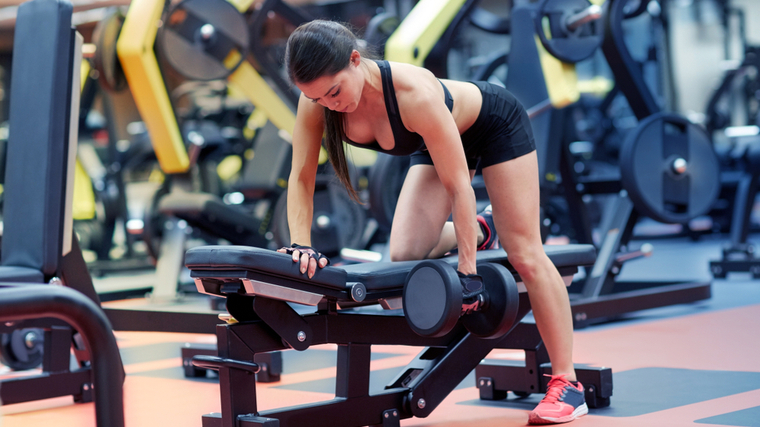
Put one hand and the same-side knee on a flat bench with a dumbbell resting on the bench between them. Your back should remain flat and your shoulder blades should be pulled down and back, towards the back pocket of your pants. Keep your head and neck neutral, not pointed up to the ceiling or down towards the ground. Your eyes can look at the ground in front of the bench.
Grab the dumbbell with the hand that isn’t on the bench. With your palm facing the bench, allow the weight to reach to the ground without pulling your shoulder joint down. Your elbow should be relatively straight, but not locked, in the stretched position.
Form Tip: The dumbbell will try to pull your body down to one side, but keep your core muscles engaged throughout the exercise to keep your hips level and maintain a straight line from your hips to your neck.
Step 2 — Lift the Weight Towards Your Hip
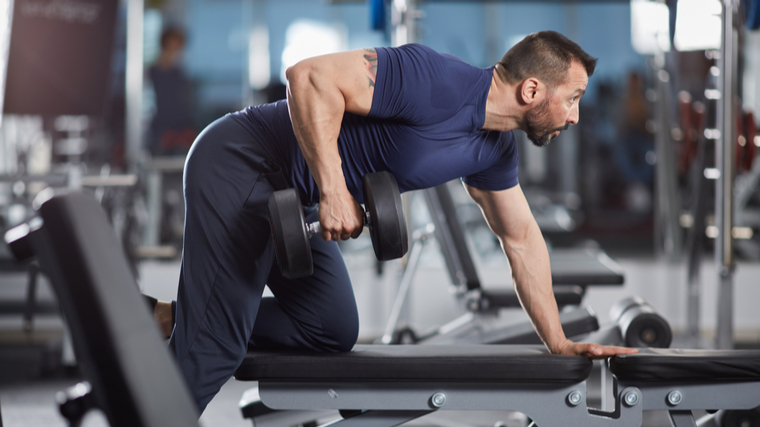
Bend your elbow to slide the weight towards the hip on the same side. Maintain a neutral hand position, with your palm facing the bench and your body. Keep your elbow close to the body to maximally engage the lat muscle.
Keep your hand in line with your forearm, directly beneath your elbow. In the top position, your forearm should be near your ribs and the weight should almost touch your hip.
Form Tip: As you pull the weight up, don’t over-rotate your shoulders or twist your trunk. Avoid jerking the weight or heaving your upper body to create momentum.
Step 3 — Lower to the Stretched Position
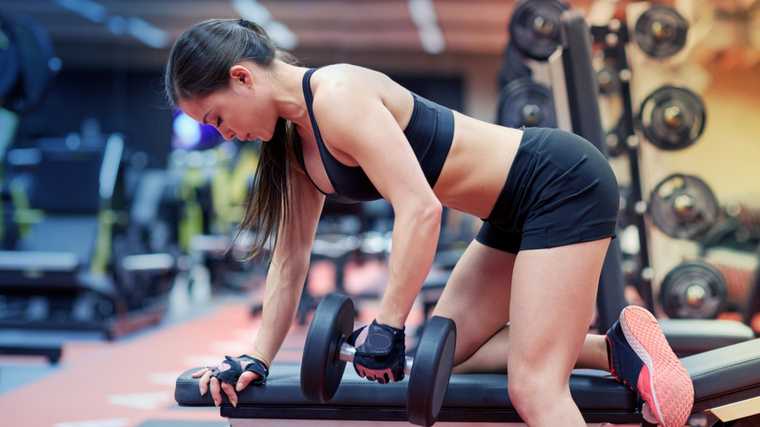
Slowly reverse direction to lower the weight back to the starting point. Be sure the weight moves in a slight arc away from your hip until your arm is nearly straight with the weight directly under your shoulder.
Form Tip: Don’t lose your shoulder placement as you lower the weight. Keep your shoulder locked into your shoulder girdle and pulled away from the ear, not shrugged up towards your ear or towards the ceiling.
Single-Arm Dumbbell Row Mistakes to Avoid
Most form problems with the single-arm row have to do with losing proper position of the torso, shoulder, or arm. Maintaining focus on body awareness and simple technique cues can help you to avoid these issues.
Sagging Lower Back
Losing core engagement can cause the lower back to start to drop toward the bench. This can cause back pain or injury by increasing strain on the vertebrae.
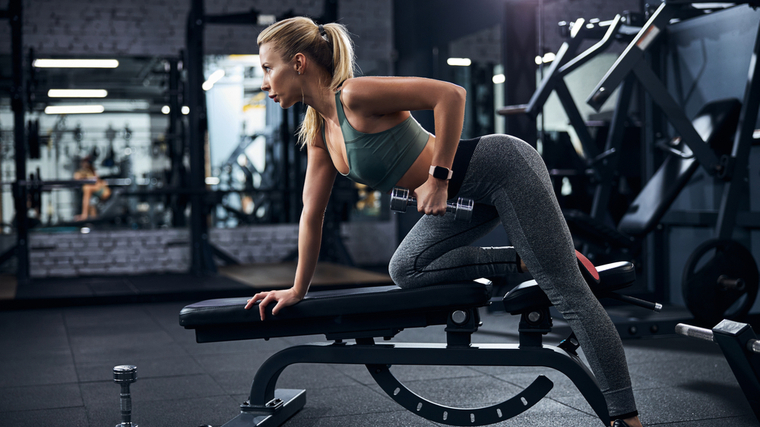
Avoid It: Imagine lengthening your spine in both directions, from your tailbone to your neck. Keep your abs tense. Don’t allow your hips to rotate, which can encourage your lower back to drop out of position.
Curving the Spine Upward
Just like a sagging spine, the opposite is possible and equally problematic. You want to maintain a neutral torso, neither rounded or curved excessively, in order to keep your joints aligned for optimal power output and muscle recruitment.
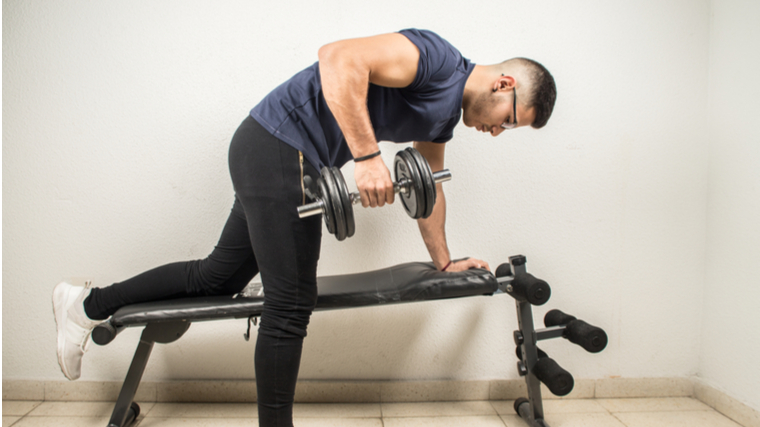
Losing a neutral-spine position and curving too far up will prevent the shoulder from achieving a full range of motion. This will make the exercise less effective and can strain the shoulder joint.
Avoid it: Think of keeping your upper body flat with strong abs and steady, stable hips.
Dropping Out of the Shoulder Joint
Especially in the eccentric (lowering) portion of the exercise, the shoulder placement can get lost as the weight “pulls” the arm downward.
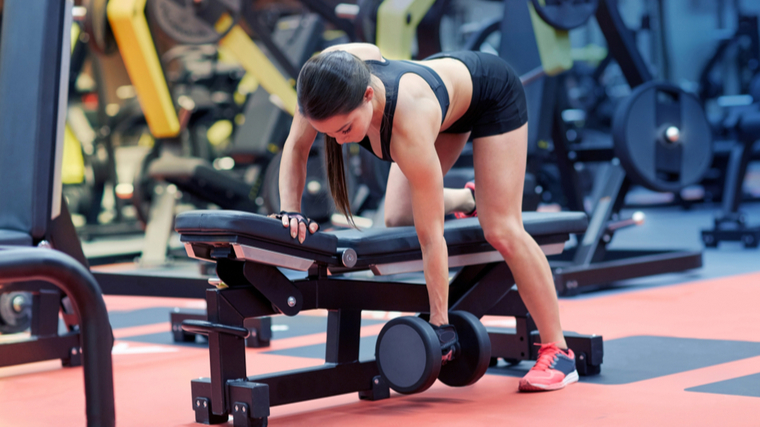
If the shoulder drops out of the shoulder girdle and the shoulder blades come forward, you can be exposed to shoulder pain or injury.
Avoid it: Keep your shoulder blade pressed towards your back pocket throughout the exercise, especially while lowering the weight into the stretched position.
Benefits of the Single-Arm Dumbbell Row
The single-arm row is one of the most efficient ways to build size and strength in the back, shoulders, and arms.
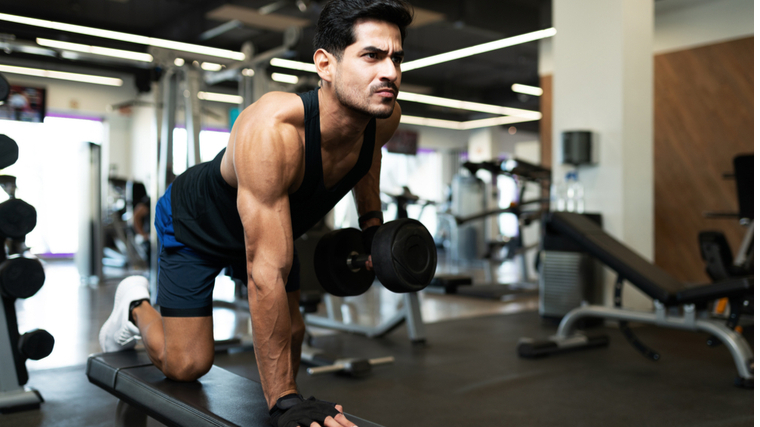
The movement works a majority of muscles in the upper body and can be used to emphasize muscular size or strength.
Training for a V-Taper Physique
The single-arm row can add muscular size to the shoulders, upper back, and lats to create an ideal v-taper, or inverted triangle, physique. This gives the appearance of an athletic, well-developed body.
Training for Strength
Building strength in the muscles of the back can carry over to improved stability when supporting the weight during heavy bench presses, overhead presses, and countless other exercises.
Improved Shoulder Health
Because the single-arm row activates upper back muscles including the trapezius and rhomboids, it can be beneficial for overall scapular health and shoulder function.
Muscles Worked by Single-Arm Dumbbell Row
The single-arm row is a thorough upper body exercise because it incorporates several muscles in one movement.
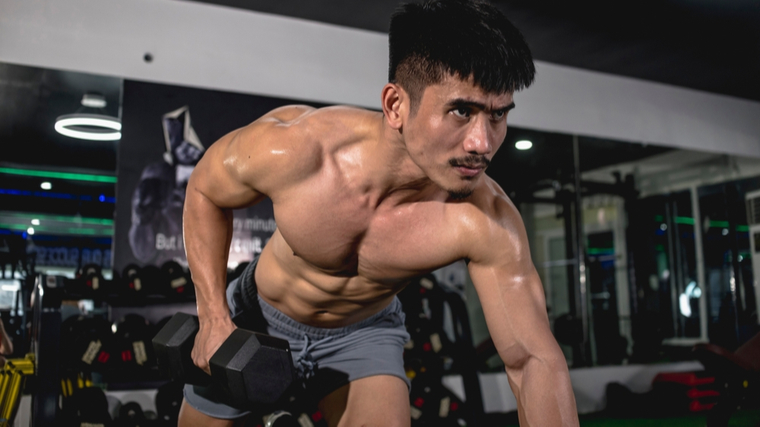
Like many multi-joint (compound) exercises, it’s an efficient choice for a variety of workout programs.
Latissimus Dorsi
The largest back muscle, the latissimus dorsi or “lat,” is the primary muscle being recruited during single-arm rows. The lats are found on both sides of your back, running from the shoulder blades to below the ribs. They primarily work to draw the upper arm towards the centerline of your body.
Upper Back
The upper back consists of several relatively more minor muscles running across the shoulder blades, including the rhomboids, rear deltoids (shoulders), and teres major and minor. These muscles share similar roles for scapular (shoulder blade) mobility and stability.
Biceps Brachii
The biceps, found on the front part of the upper arm, work to bend and flex the elbow. They are recruited secondarily, not as primary movers, during the row.
Who Should Do the Single-Arm Dumbbell Row
The single-arm row is compatible with most lifters. It’s a useful addition to a beginner’s upper body training and it can be trained long-term as you progress in form and weight as you go along.
Lifters Training for Muscle Size
The single-arm row has been a bodybuilding staple for decades because it focuses the muscle-building stimulus on one side of the body at a time, which allows for more focused training and symmetrical growth and development.
Beginning Lifters
The support of the bench will help to focus on form. It’s an excellent way to train multiple muscles while increasing back strength. The single-arm row is a foundational exercise which helps to build a base of general strength.
Frequent Sitters
If you sit for work, stare at a computer screen for a big part of your day, or find that you are starting to get a forward roll in your upper back, the single-arm row can help to counteract alignment issues and postural problems by strengthening the upper back.
How to Program the Single-Arm Dumbbell Row
The single-arm row is versatile and can be used in a range of programming for all complete back and shoulder development.
Single-Arm Row for Size Gains
If you are working on gaining size in the lats, use the single-arm row on a low-rep, high-weight upper body day. Perform three to four sets of six to eight reps using a weight that makes the last two reps very difficult to complete. Never lose stability in the shoulder or core, even when lifting heavy.
Single-Arm Row for Mobility
The single-arm row can be programmed to improve shoulder and upper back mobility. This approach will focus on good alignment in the spine, stability in the shoulder, and a slow eccentric (lowering) motion. Take one second to raise the weight and three seconds to lower it — think “up, down, down, down.” This type of training uses a moderate weight for two to three sets of 10 to 12 repetitions, with the last two reps being relatively difficult to complete at the slow tempo.
Single-Arm Row for Recovery
If you are recovering from a shoulder overuse injury, consider performing the exercise without weights or with one to five pounds, for one or two sets of 20 to 25 reps. The purpose here is just to keep the joint mobile and increase the flexibility of the muscles around the joint.
Single-Arm Dumbbell Row Variations
Minor adjustments to hand or body position, or range of motion, can challenge your muscles in a new way and alter muscle recruitment for more variety.
Floor Single-Arm Row
No bench? No problem. Use the floor. Get down on your hands and knees. Mimic the same positioning of your back and shoulders. Place the dumbbell weight under your hand and pull from there. The weight can touch the floor at the bottom of the exercise.
This can be an ideal option for lifters with shoulder issues because the range of motion is reduced and the floor supports the bottom of the exercise, rather than the weight hanging freely by your side.
Self-Supported Single-Arm Row
Stand with slightly bent legs while bent forward at the waist in a hinge position. Support yourself with your non-working hand on your thigh. Perform the row the same way as you would with a bench. Make sure you don’t raise your torso and turn the exercise into a shrug.
If balance is an issue, you can stand in a lunge-type position with your feet staggered while resting your free hand on the forward leg.
Supinated Single-Arm Row
Instead of the palm facing the side of the body, turn your palm towards the front (supinated) and maintain this hand position during the exercise. This significantly recruits the biceps while also involving the lats.
This grip adjustment also allows you to pull the weight higher into your hip, which changes the feel of the peak contraction.
Elbow-Out Single-Arm Row
This variation emphasizes the upper back much more than the lats, making it a more effective exercise for targeting upper back size and/or shoulder health. (1)
Face your palm towards your feet throughout the set and row with your elbow to the side in line with your shoulder, rather than close to your ribs. In the top position, your shoulder, elbow, and hand should form a 90-degree angle from your body.
Single-Arm Dumbbell Row Alternatives
Lots of exercises are great for the upper back, and it’s great to change them up or add some to your regular routine.
Seated Row
The seated row can be performed at a cable station or with a resistance band around the feet, sitting on the floor.
Keep a tall upper body posture and stable body position, and work through a full range of motion using a thumbs-up grip for optimal back and shoulder recruitment.
Lat Pulldown
The pulldown is a fundamental vertical pulling exercise for strengthening the lats. Keep your shoulders down and back during the exercise in order to also recruit your upper back.
Keep your core engaged and don’t allow your spine to round. In the bottom position, your elbows should be slightly behind you for a complete muscular contraction.
FAQs
Why do I feel the single-arm dumbbell row mostly in my biceps?
Double-check your form. Make sure you have good spinal alignment and an engaged core. Don’t allow your shoulder to reach out of the shoulder girdle. most importantly, focus on pulling the weight back toward your hip, instead of towards your shoulder, to engage more lat muscle and less biceps.
Why does my neck hurt during the exercise?
You’re likely trying to look forward, which is cranking your neck in an awkward position. Keep your gaze down to the floor slightly in front of the bench, not up towards the wall or mirror and not down towards your hand on the bench.
One Arm, All the Gains
The single-arm dumbbell row is a key player in long-term training. Mastering this fundamental exercise as a beginner can pay off with wider lats, a stronger upper back, and healthier shoulders in the long-run. Grab your bench and start rowing.
References
- Fennell, J., Phadke, C. P., Mochizuki, G., Ismail, F., & Boulias, C. (2016). Shoulder Retractor Strengthening Exercise to Minimize Rhomboid Muscle Activity and Subacromial Impingement. Physiotherapy Canada. Physiotherapie Canada, 68(1), 24–28. https://doi.org/10.3138/ptc.2014-83
Featured Image: antoniodiaz / Shutterstock
The post How to Do the Single-Arm Dumbbell Row for Bigger Lats appeared first on Breaking Muscle.







